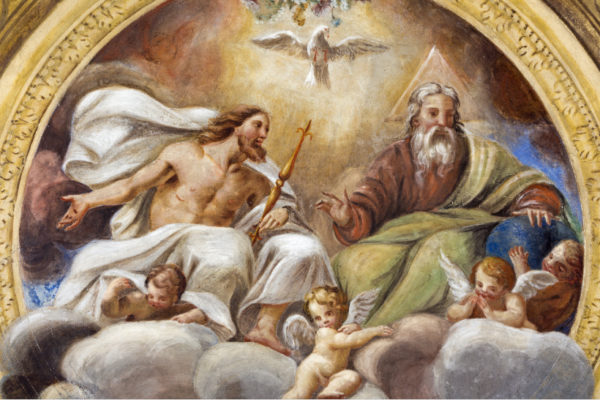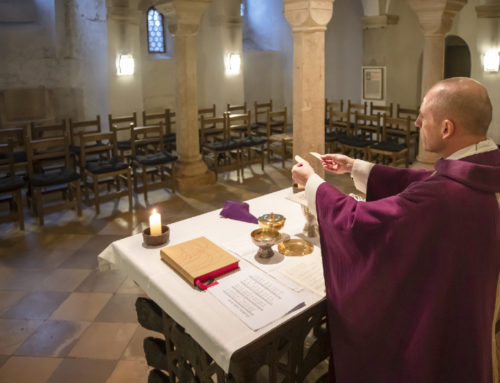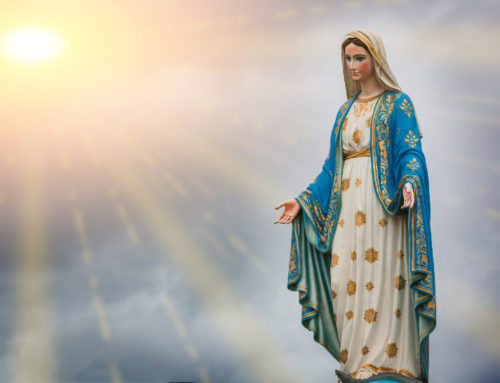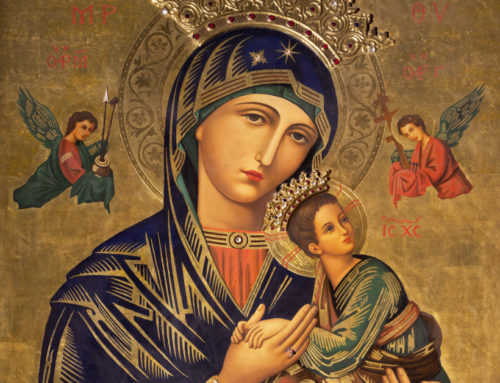
The ceiling freso of The Holy Trinity in church Chiesa di Santa Croce by Giovanni Maria Conti della Camera
What is the filioque and why is it an issue between East and West?
This question requires a three-part answer. First, we’ll address the meaning of the filioque, then the theology behind the filioque, and finally we’ll address the “political” issues surrounding it.
First, the Latin word filioque simply means “and the son” (Latin filius means “son” and the –que ending means “and”). This word was added to the Nicene Creed in Spain in 587 (at the Council of Toledo, a local council) to counter a heresy called “Arianism.”
Second, the goal theologically was to make sure that the people understood that not only were the Father and the Son consubstantial – meaning “of the same substance” – but that the Holy Spirit was also of that same substance. The result was that instead of reading, “and in the Holy Spirit, the Lord, the giver of life, who proceeds from the Father…,” it now read, “and in the Holy Spirit, the Lord, the giver of life, who proceeds from the Father and the Son…,” This seems to indicate that the Father is no longer the sole source of divine life because the Holy Spirit proceeds from both the Father and the Son. Theologians had to explain this. The result was the theological statement that the Son was “generated” by the Father and the Holy Spirit was “spirated” by the Father and the Son. Another explanation is that the Son is the “Word” thought by the Father and the Holy Spirit is the bond of love between Father and Son. Both these explanations have been understood by the Orthodox as an indication that the Father alone did not produce the Son and the Holy Spirit.
A more recent theological explanation used in dialogue with the Orthodox has attempted to provide a more scripturally sound understanding. Here the theologians postulate that the Holy Spirit is spirated from the Father through the Son. This is based upon John 15:26, where we read, “When the Advocate comes, whom I will send to you from the Father, the Spirit of truth who comes from the Father, he will testify on my behalf.” Here the sense is clear that the Son sends the Holy Spirit – but that the Holy Spirit comes from the Father.
Last, there are three major political issues that need to be understood (and the term political here does not mean to mitigate the severity of the issues at hand): 1. the history of why this action was taken; 2. the fact that this phrase was unilaterally inserted into the Creed; and 3. the implications of this action on the universality of the church.
During the fourth century, a priest named Arius began to teach that the Son, Jesus, was not of the same substance as the Father and that there was a time when the Son did not exist. This was countered by the teaching of the First Council of Nicaea (325) in which the church fathers asserted that the Father and the Son were of the same substance (in Greek, homoousios, literally, “same substance”). The primary statement of this was the Nicene Creed. This didn’t end the controversy, however. Some bishops thought that the term should be homoiousios, meaning “of like substance.” The First Council of Constantinople (381) again attempted to resolve the argument. This resulted in a slight change to the Creed (officially now the Nicene-Constantinopolitan Creed). The reason for bringing all this up is to show that the Creed could be changed, but only by the Universal Church in ecumenical council.
But these two councils did not end the problem. A convert to Arian Christianity named Ulfilas (311-380/381) spread the message of Arianism to the Germanic regions of Europe. By the time the German people entered into the Roman Empire, they had a full century of training and education in the Arian form of Christianity. Clearly, the result was a conflict between the orthodox teachings of the empire and the heretical teachings the Germanic peoples were following. One consequence of this conflict was that Arianism spread to Spain. It was there that the Council of Toledo made the decision to change the Creed by inserting the word filioque in 587.
From Spain the modified Creed spread to the Frankish lands. It was embraced by Charlemagne (Charles I, the King of the Franks) in 794. Pope Leo III (795-816) decreed that the modified Creed was not to be used, and had the Nicene-Constantinopolitan Creed inscribed in Latin and Greek on tablets in St. Peter’s. His order, however, was not effective in the land of the Franks, who continued to use the modified Creed. Eventually (1014) the modified Creed was used in Rome. It is, today, the Creed used by all Latin Rite Catholics (although the pope does not use it when praying with Eastern Catholics).
Because the filioque was inserted by a synod or local council, the Eastern Churches simply thought it would go away. when that failed to happen, they rejected it, since they believed that any change to the Creed, which is a statement of the Universal Church, should come from the Universal Church in ecumenical council.
For more on this very interesting topic, one can read on the USCCB website the statement entitled, The Filioque: A Church Dividing Issue? An Agreed Statement of North American Orthodox-Catholic Theological Consultation. This document provides a great deal of history and the theology behind the issue, far beyond what we’ve gone into here.
Excerpt from Faulk, Edward. 101 Questions and Answers on Eastern Catholic Churches. (Paulist Press: Mahwah, NJ) 2007.




